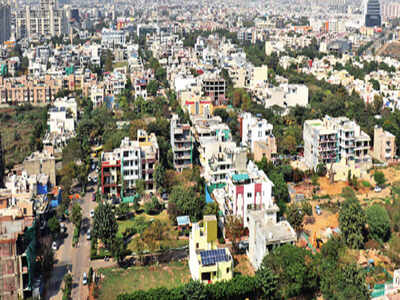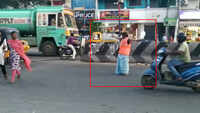
GURUGRAM: The state rolls out the red carpet for CEOs looking to invest in the city. The welcome pleases them but reality strikes soon after as the car gets stuck in a jam or bounces along a road whose surface has just been washed away by a spell of rain. When they look out of the window, they see people wearing masks, jumbo generator sets in compounds of offices and clouds of dust at construction sites. And cars, in thousands, filling up the wide streets in seconds.
Gurugram is the oxygen of Haryana’s economy but is choking on air pollution. It powers the state’s GDP but rarely sees a day pass without a power cut. And while the highway for Haryana’s growth originates here, the city’s roads are so crammed that getting anywhere on time is a challenge.
There is another irony Gurugram has been living with year after year; though its roads flood easily whenever it rains, the height of the problem varying between knee and ankle deep on most roads, its groundwater aquifers are struggling to stay hydrated because water is gushing into drains instead of percolating down, thanks to rampant concretisation.
Why should the city and its residents have to struggle so much for basic amenities? For the right to safe air, clean water, smooth roads and continuous electricity? Why isn’t improving livability an election promise? Why can’t political manifestos be designed around making lives easier, increasing convenience?
The assembly elections are scheduled next month and it’s time to not only ask these questions but set the agenda for parties. What do you think should be the main priorities of the new Haryana government? Are you satisfied with the way Gurugram is governed? With a large part of its territory in NCR, should all of Haryana be governed in one, homogenous way? Your opinion matters.
Beginning today, we invite you to write to us about key issues you would like to see in election manifestos and set as the main tasks for the new government. We at TOI will publish the best manifestos we receive to draw the attention of political leaders. The manifestos for Gurugram you send must represent the major issues in the city and explain why you think so.
Let’s join hands for a better Gurugram, a city where people set the agenda.
Are pothole-free roads too much to ask for?
Over the last couple of years, multiple underpasses and flyovers have been built to make the road network of the city stronger. Redevelopment of Huda City Centre, Mahavir Chowk and Shankar Chowk are under way. But bigger than this development story are the potholes that never seem to get evened out and the sinkholes that open up every monsoon. Besides, several new sectors are still not connected with proper roads. And to make matters worse for residents of the places where most of Gurugram’s development will happen over the coming years, there has been little headway in shifting the Kherki Daula toll plaza, an assurance the Manohar Lal Khattar government gave the city. The toll plaza has become a problem because the city has grown well beyond it and residents have rightly pointed out that it makes no sense for people commuting within a city to pay toll.
Electricity, 24x7. The outages need to stop
Thousands of families have moved to Gurugram with the hope of a better life but the civic authorities have failed them in many ways. No matter how luxurious a condominium, it is not protected from powercuts, sometimes for hours at a stretch. This summer, long outages became a norm across residential colonies. Besides, many of the new highrises along the Southern Peripheral Road that connects Sohna Road with NH8 and Dwarka expressway are still without official electricity connections and completely rely on diesel generators. The discom, Dakshin Haryana Bijli Vitran Nigam, has projected a sharp rise in consumption of electricity every year. It posited that the “Zero Outage” project would put an end to the city’s power supply problem but this has missed multiple deadlines for completion. It might take till 2022 and Rs 1,600 crore to be functional, the electricity department says. But while that is on, the city needs to eliminate power cuts.
More metro lines, and comfortable buses
The volume of buses plying the city roads is merely a fifth of what the minimum requirement is, experts say. With the metro extension beyond Huda City Centre being stuck in time, and the future of the Rapid Metro corridor looking uncertain, transport becomes a daily cause for stress for residents. The state government is working on extending the metro service from Huda City Centre to Sector 23. The project will take at least four more years to be completed. Other projects in the pipeline like RRTS, MRTS and Gurugram- Faridabad metro link are in the initial phases and still being assessed for financial viability. As for buses, the state government on multiple occasions had promised 200 buses to be rolled out by this summer. So far, only 100 of them have started plying. Also, until residents are provided with AC buses, the comfort factor that can convince car users to switch to public transport will remain missing.
A serious action plan against air pollution
Gurugram topped the list of the world’s most polluted cities compiled by the IQAir AirVisual 2018 World Air Quality Report, prepared in coordination with Greenpeace Southeast Asia. Come winter, the air is thick with particulate matter and with every breath, residents inhale toxic air. In response, so far, the authorities have been able to install only one new air pollution monitoring station in the last five years in Gurugram. While stubble burning in Haryana is less than in Punjab, it is still the main cause of the winter menace. The city needs stringent pollution monitoring, proper implementation of the ban on stubble burning, reliable power infrastructure to reduce dependence on diesel gensets, and better roads and transport to bring down dust emission levels and vehicular pollution.
No fear of a future without water
Gurugram was marked ‘over-exploited’ by the Central Ground Water Board in 2013 but the city continues to witness 1.5-2 metres decline of the water table every year. About 83% of the entire decline has been reported in the past 12 years, in sync with the city’s explosive growth. The district, with all four blocks — Sohna, Farrukhnagar, Pataudi and Gurugram— has been marked as a dark zone by the board. One of the major reasons for the groundwater depletion is illegal extraction of groundwater for construction. Another is lack of groundwater recharge. A proper piped water connection should be provided to all residents to check illegal extraction of groundwater. A policy for water recharge must be formulated.
Protect Aravalis to preserve ecosystem
Gurugram also worries about its immediate natural surroundings. For hundreds of years, the Aravali hills have been instrumental in shaping the climate of the upper Indo-Gangetic plain. From rainfall, temperature and aquifer recharge to soil conservation, biodiversity and ecology, every factor has been dependent on this range. Now, they are vulnerable and the Haryana government has failed to protect it. The government’s decision to lift the 100-year-old Punjab Land Preservation Act from the Aravali foothills, which have enjoyed its protection, is likely to have an impact on the natural ecosystem of Gurugram and Faridabad. This could result in further groundwater crisis, desertification and air pollution in Delhi-NCR. Besides, despite the state having the lowest forest cover in the country, the government has not identified forests to protect them. It needs to be done urgently.
Send in your suggestions to toi.Gurugram@timesgroup.com or log on to www.TOI.in/GGID and
create your manifesto for our city
Gurugram is the oxygen of Haryana’s economy but is choking on air pollution. It powers the state’s GDP but rarely sees a day pass without a power cut. And while the highway for Haryana’s growth originates here, the city’s roads are so crammed that getting anywhere on time is a challenge.
There is another irony Gurugram has been living with year after year; though its roads flood easily whenever it rains, the height of the problem varying between knee and ankle deep on most roads, its groundwater aquifers are struggling to stay hydrated because water is gushing into drains instead of percolating down, thanks to rampant concretisation.
Why should the city and its residents have to struggle so much for basic amenities? For the right to safe air, clean water, smooth roads and continuous electricity? Why isn’t improving livability an election promise? Why can’t political manifestos be designed around making lives easier, increasing convenience?
The assembly elections are scheduled next month and it’s time to not only ask these questions but set the agenda for parties. What do you think should be the main priorities of the new Haryana government? Are you satisfied with the way Gurugram is governed? With a large part of its territory in NCR, should all of Haryana be governed in one, homogenous way? Your opinion matters.
Beginning today, we invite you to write to us about key issues you would like to see in election manifestos and set as the main tasks for the new government. We at TOI will publish the best manifestos we receive to draw the attention of political leaders. The manifestos for Gurugram you send must represent the major issues in the city and explain why you think so.
Let’s join hands for a better Gurugram, a city where people set the agenda.
Are pothole-free roads too much to ask for?
Over the last couple of years, multiple underpasses and flyovers have been built to make the road network of the city stronger. Redevelopment of Huda City Centre, Mahavir Chowk and Shankar Chowk are under way. But bigger than this development story are the potholes that never seem to get evened out and the sinkholes that open up every monsoon. Besides, several new sectors are still not connected with proper roads. And to make matters worse for residents of the places where most of Gurugram’s development will happen over the coming years, there has been little headway in shifting the Kherki Daula toll plaza, an assurance the Manohar Lal Khattar government gave the city. The toll plaza has become a problem because the city has grown well beyond it and residents have rightly pointed out that it makes no sense for people commuting within a city to pay toll.
Electricity, 24x7. The outages need to stop
Thousands of families have moved to Gurugram with the hope of a better life but the civic authorities have failed them in many ways. No matter how luxurious a condominium, it is not protected from powercuts, sometimes for hours at a stretch. This summer, long outages became a norm across residential colonies. Besides, many of the new highrises along the Southern Peripheral Road that connects Sohna Road with NH8 and Dwarka expressway are still without official electricity connections and completely rely on diesel generators. The discom, Dakshin Haryana Bijli Vitran Nigam, has projected a sharp rise in consumption of electricity every year. It posited that the “Zero Outage” project would put an end to the city’s power supply problem but this has missed multiple deadlines for completion. It might take till 2022 and Rs 1,600 crore to be functional, the electricity department says. But while that is on, the city needs to eliminate power cuts.
More metro lines, and comfortable buses
The volume of buses plying the city roads is merely a fifth of what the minimum requirement is, experts say. With the metro extension beyond Huda City Centre being stuck in time, and the future of the Rapid Metro corridor looking uncertain, transport becomes a daily cause for stress for residents. The state government is working on extending the metro service from Huda City Centre to Sector 23. The project will take at least four more years to be completed. Other projects in the pipeline like RRTS, MRTS and Gurugram- Faridabad metro link are in the initial phases and still being assessed for financial viability. As for buses, the state government on multiple occasions had promised 200 buses to be rolled out by this summer. So far, only 100 of them have started plying. Also, until residents are provided with AC buses, the comfort factor that can convince car users to switch to public transport will remain missing.
A serious action plan against air pollution
Gurugram topped the list of the world’s most polluted cities compiled by the IQAir AirVisual 2018 World Air Quality Report, prepared in coordination with Greenpeace Southeast Asia. Come winter, the air is thick with particulate matter and with every breath, residents inhale toxic air. In response, so far, the authorities have been able to install only one new air pollution monitoring station in the last five years in Gurugram. While stubble burning in Haryana is less than in Punjab, it is still the main cause of the winter menace. The city needs stringent pollution monitoring, proper implementation of the ban on stubble burning, reliable power infrastructure to reduce dependence on diesel gensets, and better roads and transport to bring down dust emission levels and vehicular pollution.
No fear of a future without water
Gurugram was marked ‘over-exploited’ by the Central Ground Water Board in 2013 but the city continues to witness 1.5-2 metres decline of the water table every year. About 83% of the entire decline has been reported in the past 12 years, in sync with the city’s explosive growth. The district, with all four blocks — Sohna, Farrukhnagar, Pataudi and Gurugram— has been marked as a dark zone by the board. One of the major reasons for the groundwater depletion is illegal extraction of groundwater for construction. Another is lack of groundwater recharge. A proper piped water connection should be provided to all residents to check illegal extraction of groundwater. A policy for water recharge must be formulated.
Protect Aravalis to preserve ecosystem
Gurugram also worries about its immediate natural surroundings. For hundreds of years, the Aravali hills have been instrumental in shaping the climate of the upper Indo-Gangetic plain. From rainfall, temperature and aquifer recharge to soil conservation, biodiversity and ecology, every factor has been dependent on this range. Now, they are vulnerable and the Haryana government has failed to protect it. The government’s decision to lift the 100-year-old Punjab Land Preservation Act from the Aravali foothills, which have enjoyed its protection, is likely to have an impact on the natural ecosystem of Gurugram and Faridabad. This could result in further groundwater crisis, desertification and air pollution in Delhi-NCR. Besides, despite the state having the lowest forest cover in the country, the government has not identified forests to protect them. It needs to be done urgently.
Send in your suggestions to toi.Gurugram@timesgroup.com or log on to www.TOI.in/GGID and
create your manifesto for our city
Trending Topics
LATEST VIDEOS
More from TOI
Navbharat Times
Featured Today in Travel
Quick Links
Lok Sabha Election Schedule 2019Lok Sabha Election NewsDelhi Capitals teamMI team 2019Rajasthan Royals 2019RCB team 2019Maharashtra Lok Sabha ConstituenciesBJP Candidate ListBJP List 2019 TamilnaduShiv Sena List 2019AP BJP List 2019Mamata BanerjeeBJP List 2019 MaharashtraPriyanka GandhiBJP List 2019 KarnatakaAMMK Candidate List 2019BJP List 2019 WBLok Sabha Elections in Tamil NaduBSP List 2019 UPNews in TamilLok Sabha Poll 2019Satta Matka 2018PM ModiMahagathbandhanNagpur BJP Candidate ListChandrababu NaiduTamil Nadu ElectionsUrmila MatondkarNews in TeluguMadras High CourtTejashwi YadavArvind KejriwalTejasvi SuryaPawan KalyanArvind KejriwalYogi AdityanathJaya PradaSatta King 2019Srinagar encounter
Get the app







